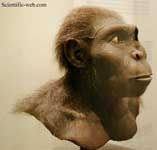
Kenyanthropus platyops (Information about this image)
Kenyanthropus platyops is a 3.5 to 3.2 million year old (Pliocene) extinct hominin species that was discovered in Lake Turkana, Kenya in 1999 by Justus Erus, who was part of Meave Leakey's team. [1] The fossil found features a broad flat face with a toe bone that suggests it probably walked upright. Teeth are intermediate between typical human and typical ape forms. Kenyanthropus platyops, which means "Flat faced man of Kenya", is the only described species in the genus. However, if some paleoanthropologists are correct, Kenyanthropus may not even represent a valid taxon, as the specimen (KNM-WT 40000)[2] is so distorted by matrix-filled cracks that meaningful morphologic characteristics are next to impossible to assess with confidence. It may simply be a specimen of Australopithecus afarensis, which is known from the same time period and geographic area. Other researches speculate that the flatter face position of the rough cranium is similar to KNM ER 1470 "Homo rudolfensis" and suspect it to be closer to the genus Homo, perhaps being a direct ancestor. However the debate has not been concluded and the species remains an enigma. The bones discovered at the site included more than 30 skull and tooth fragments in a stratum dated to between 3.5 and 3.2 million years ago. The fossil was named the Flat Faced Man of Kenya, or Kenyanthropus platyops, by Dr. Meave Leakey, of the National Museums of Kenya. Dr. Leakey believes that it belongs to an entirely new genus of ancestors, and is the oldest "reasonably complete" cranium found so far. Humans were once thought to have evolved from only one member of Australopithecus afarensis, the species made famous by the fossil Lucy. But now it seems Lucy may have been sharing the woods and grass plains of prehistoric Africa with a rival. Until more recent discoveries were made, it seemed as if the evolution of man might be “special” since there appeared to be only one single line of hominids leading from the most primitive to Modern Man of today. And since evolution normally proceeds in branches, multiplying as each branch divides, hominid evolution seemed for a while to be the one exception. Now, with the discovery of Kenyanthropus, the picture looks more “normal”.
At present anthropologists aren’t sure how many branches there might have been 3 million years ago. Branches may have gone extinct that we haven’t yet found representatives for; but such fossils could be discovered at any time. When learning of the discovery, Daniel Lieberman, an anthropologist at George Washington University expressed his opinion that between 3.5 and 2 million years ago there were several human-like species, each of which were well adapted to life in their particular environments. Also that, like that of many other mammalian groups, humans evolved through a series of complex radiations, known as "adaptive radiation".[3] The Kenyanthropus fossil has a small earhole, like those of chimpanzees. It also shares many features of other primitive hominids, such as a small brain, but it also has striking differences, including high cheek bones, and a flat plane beneath its nose bone, which gives it a flat face.
Kenyanthropus platyops (Information about this image) See also * List of fossil sites (with link directory) References 1. ^ Kenyanthropus platyops Further reading * Leakey, Meave G.; et al. (2001). "New hominin genus from eastern Africa shows diverse middle Pliocene lineages". Nature 410: 433–440. doi:10.1038/35068500. External links
Retrieved from "http://en.wikipedia.org/" |
|


